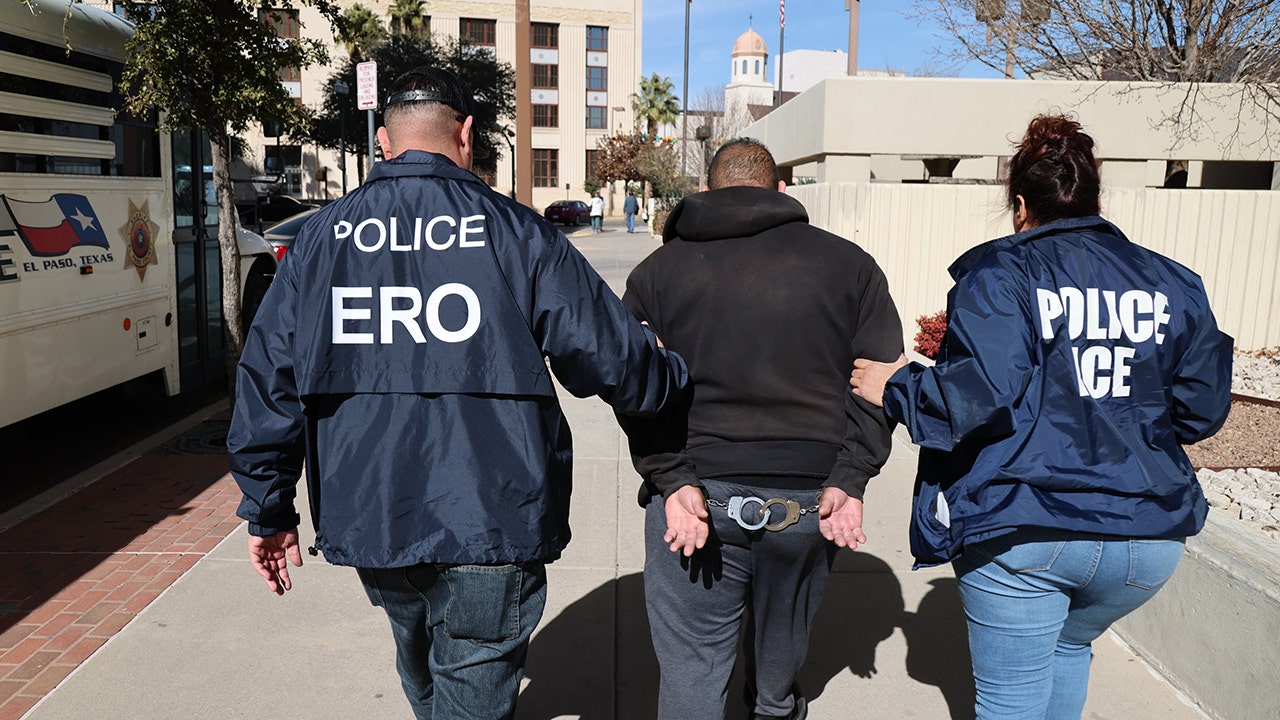Business
As high-rise offices lose their luster, can this part of downtown L.A. find a way forward?

As the pandemic shut down office life in Los Angeles’ downtown financial district, Claude Cognian tried to keep his gastropub Public School 213 open. But the evacuation of white-collar workers made way for an influx of homeless people and drug users — and more than a few troublemakers striding in the front door.
“It was hard to keep hostesses at the door, because they got scared,” said Cognian, chief executive of the restaurant’s parent company, Grill Concepts Inc.
Three break-ins cost as much as $12,000 each time just to repair the windows, all while the bottom line was cratering in the absence of the office employees who used to gather for lunch and after-work drinks. With sales down 75% from pre-pandemic days, his company closed the downtown gastropub in August and is not planning to return.
“Our bet was that downtown was going to come back, and it hasn’t,” Cognian said.
For decades the Los Angeles financial district was the beating heart of downtown, the corporate muscle that gave the city of sprawl a soaring glass skyline. But the pandemic and the wave of remote work hollowed out its skyscrapers and helped shutter many restaurants and businesses that relied on crowds of workers. While the neighborhood shows signs of recovery, few expect it to return to being the bustling hive of suits and ties that it was.
To many insiders — the urban planners, real estate developers and business owners with interests in it — the area will recover only if its identity grows more textured than a zone of white-collar office space.
Desirable office addresses were already spreading beyond the financial district before the pandemic, as downtown experienced a renaissance in housing, art and entertainment on blocks previously shunned by investors and residents.
To the south, billions of dollars were spent improving the blocks around Crypto.com Arena with hotels, housing and entertainment venues. Obsolete century-old commercial and industrial buildings to the east were renovated into desirable housing and fashionably unconventional offices. Billions more were spent north on Bunker Hill where the Music Center including Walt Disney Concert Hall and office skyscrapers have been joined by museums, apartments and a high-rise hotel.
The housing boom drew residents to the financial district as well, and that has kept it from turning into a ghost town.
But for the area to truly come back to life, many say it will need to follow the path of Lower Manhattan. The financial capital of New York faced an exodus after 9/11, but city officials and investors staved it off by making it a place of more diverse uses. It is still an office district but is far more lively than it used to be since it also became a residential neighborhood with more shops, restaurants, parks and hotels than it had before the attacks. A performing arts center will open in September.
“Cities evolve. That’s what they do,” downtown L.A. business representative Nick Griffin said. “From natural disasters, wars and pandemics. They evolve with market changes, customer preferences and cultural shifts. Downtown has evolved pretty dramatically over the last 20 years and the next five or so are going to be very interesting.”
The steel and glass skyscrapers of the financial district on Bunker Hill in Los Angeles.
(Luis Sinco / Los Angeles Times)
Many companies have returned to their offices, but on a limited basis as their employees work some days from home. “For Lease” signs clutter building fronts, tacked over restaurants and bars that once served lively hordes of office workers. Graffiti marks windows.
At Public School 213, the chairs are stacked neatly on tables as if it just closed for the night. Other former restaurants have been gutted by their landlords. Sidewalks are quiet, sometimes eerily so.
Downtown’s centers of gravity have shifted numerous times since its days as a remote Spanish pueblo.
The plaza by Olvera Street near the Los Angeles River was el centro until the late 19th century. When the railroads arrived in the American era, the business elite shifted the commercial district south from the plaza toward 1st Street in the Anglo section of the racially divided town, said Greg Fischer, an expert on the history of downtown who worked on planning matters for former City Councilwoman Jan Perry. Main, Spring, Broadway and Hill streets became the business hub.
In the early 20th century, elite social clubs the Jonathan Club, California Club and Los Angeles Athletic Club erected new buildings on the west side of downtown where property was relatively cheap. Soon the rooming houses, small apartment buildings and ramshackle Victorian homes there gave way. Richfield and other oil companies headquartered there, the seeds of today’s financial district.
In “the Jetsons era,” as Fischer described the 1960s, corporate leaders viewed the Spring Street-centered office district as increasingly obsolete and passé, and moved to newer buildings in the financial district. Downtown lost a lot of its lifeblood during that time, he said.
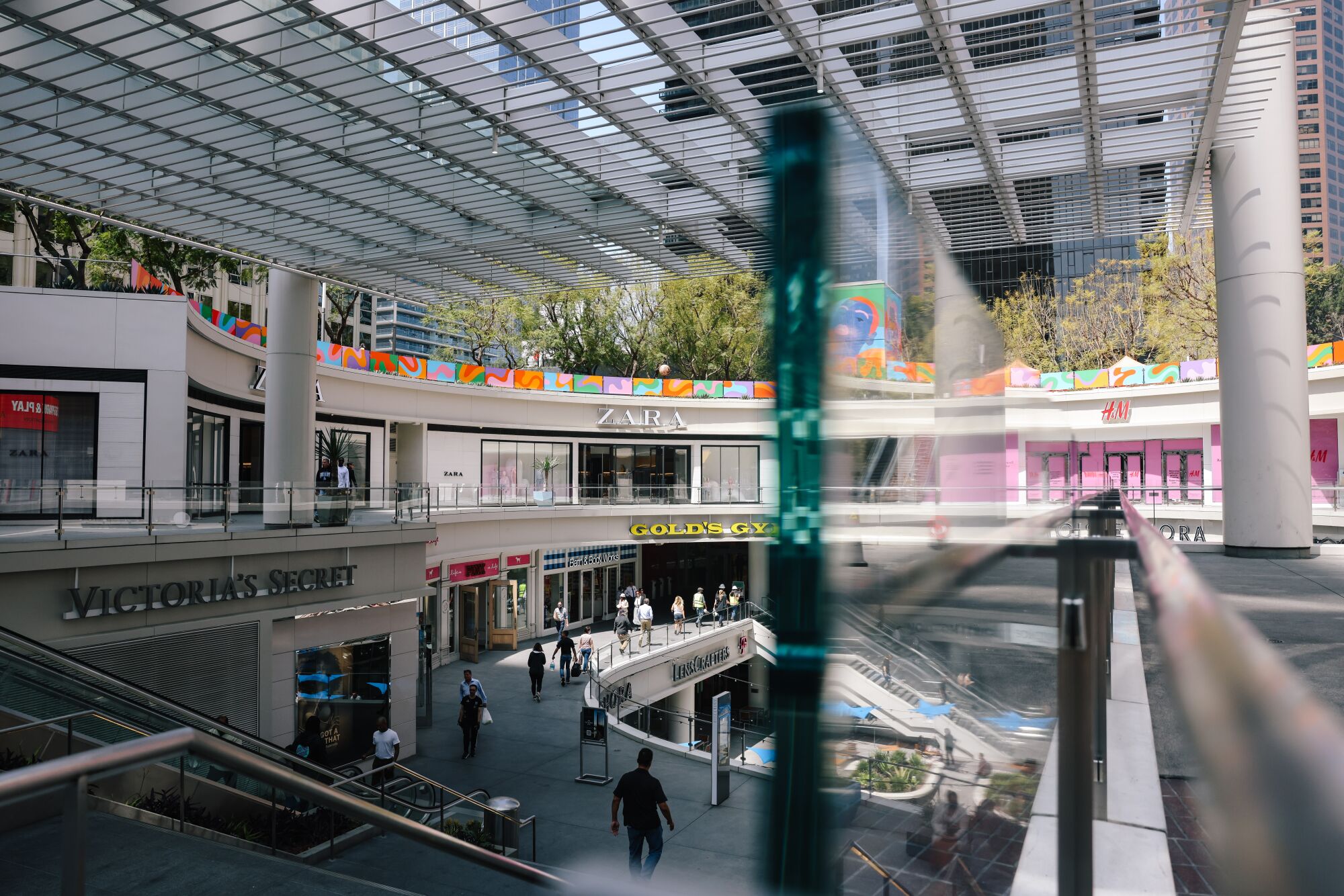
People walk midday at the Figat7th outdoor mall in downtown L.A.’s financial district.
(Dania Maxwell/Los Angeles Times)
“In the years after World War II, downtown was a shopping, office and entertainment area,” Fischer said. “By the 1960s the office component had shifted west, most entertainment went to suburbs and housing just evaporated.”
Among the big businesses with offices in the west were Richfield, Union, Signal, National and Superior oil companies. Pacific Mutual Life Insurance Co. was headquartered there and Bank of America had a big presence.
The boundaries of the financial district are not officially outlined, but property brokerage CBRE defines it as the office center south of Bunker Hill and 4th Street, flanked on the west by the 110 Freeway and on the east by Hill Street and extending south to 8th Street.
By the 1980s, much of downtown was moribund; buildings that once thrummed with commerce were dilapidated and vacant or underused. There were pockets of vibrancy, notably the Jewelry District and a Latino-centric shopping zone that emerged among aging buildings along Broadway in the Historic Core. The Civic Center around City Hall remained one of the largest concentrations of public administrative buildings in the country, employing thousands of workers.
But the financial district was the shiny thriving part of the city, a high-rise office park for lawyers, bankers and accountants who piled into their cars for a mass exodus at the end of each workday.
To many, the neighborhood felt like a corporate fortress, invisibly walled off from the rest of downtown. Business leaders were painfully aware that downtown L.A. lacked the vibrancy of other big cities because it had so few residents, but was stuck in a chicken-and-egg dilemma: People didn’t want to live there because it lacked restaurants, grocery stores and other typical city-life amenities, but merchants didn’t want to set up shop because few lived there.
The stalemate began to break around 2000 with an ordinance that made it easier to redevelop obsolete office buildings into housing. The relocation of the Lakers, Clippers and Kings pro sports teams to the new downtown arena then known as Staples Center brought thousands of sports and music fans and led a wave of development south of the financial district.
Decades of efforts to add rail service and thousands of apartments and condominiums helped create a more vibrant downtown that was taking on the flavor of other big cities before the pandemic.
“All of a sudden people were walking dogs and pushing baby carriages,” architect Martha Welborne said. “New restaurants came in, even destination restaurants that weren’t just for the people who worked downtown or lived there.”
Fortunately for downtown’s future prospects, its apartment towers remain nearly fully occupied. More than 35,000 units were built after 1999, when so few people lived there that downtown didn’t even have a big-chain grocery store.
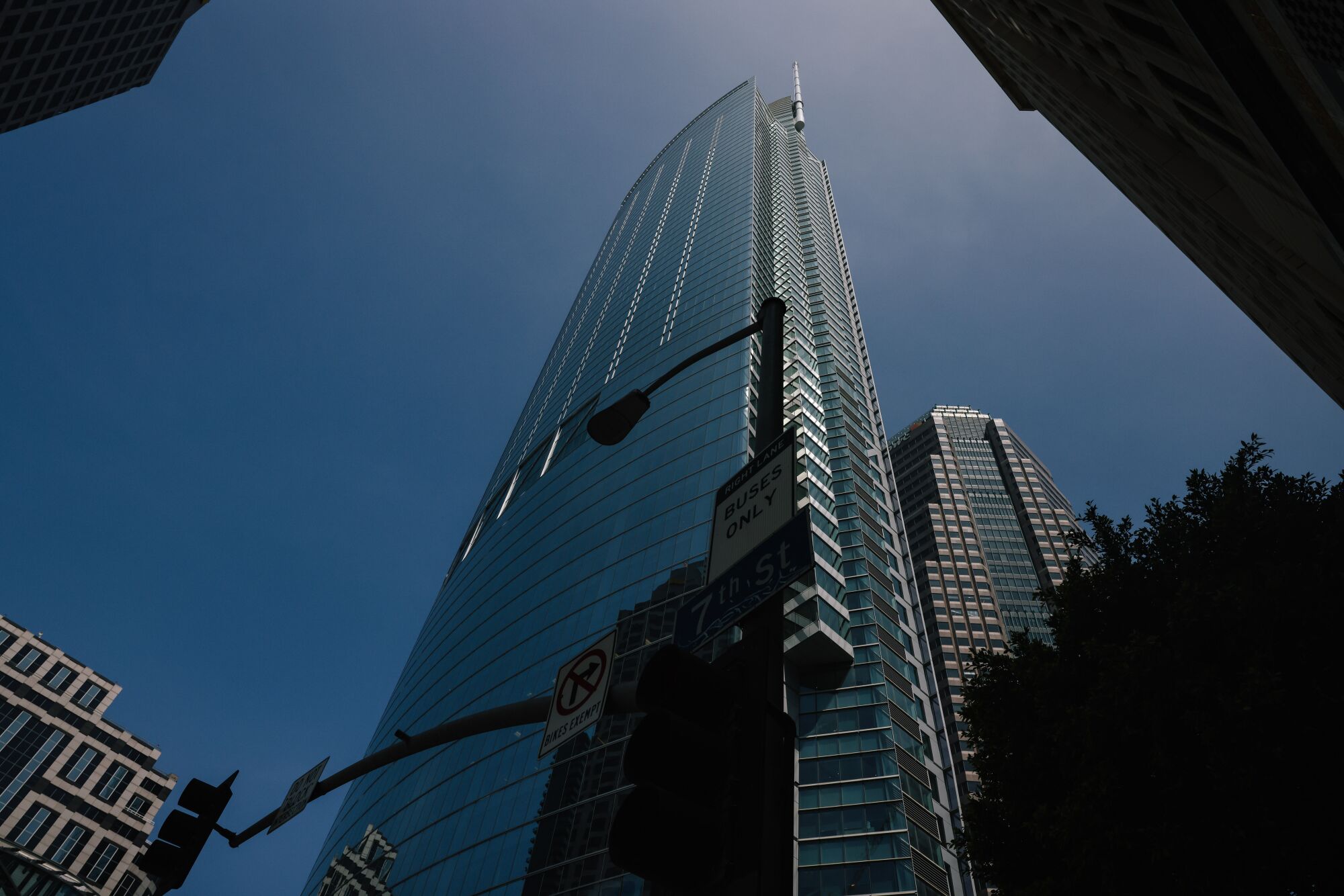
Wilshire Grand Center, a hotel and office skyscraper that is one of the tallest buildings in the West, towers over the financial district.
(Dania Maxwell/Los Angeles Times)
Three new hotels have recently opened and a 42-story apartment tower will start leasing later this year. Bottega Louie, one of the region’s top-grossing restaurants before it shut down for the pandemic, reopened in 2021. A few blocks away, legendary Beverly Hills steakhouse Mastro’s also opened a seafood restaurant last year near Crypto.com Arena.
And last week, Metro opened its new Regional Connector, a 1.9-mile underground downtown track adding three stations and linking different lines to make travel more seamless.
While some business owners have abandoned the financial district, others see opportunity to get in at an affordable price during what they hope is a temporary economic dip.
Restaurateur Prince Riley recently leased a spot on Grand Avenue that was last home to the Red Herring restaurant. He grabbed it because he liked the location and it was already built-out for upscale dining.
“You can see all the love and care that went into this space,” he said. “They were a casualty of COVID.”
Riley and his wife plan to open their restaurant, named Joyce, in July, featuring Southern-style seafood such as crudo, ceviche and a raw bar. They moved into the apartment building upstairs to be close to it.
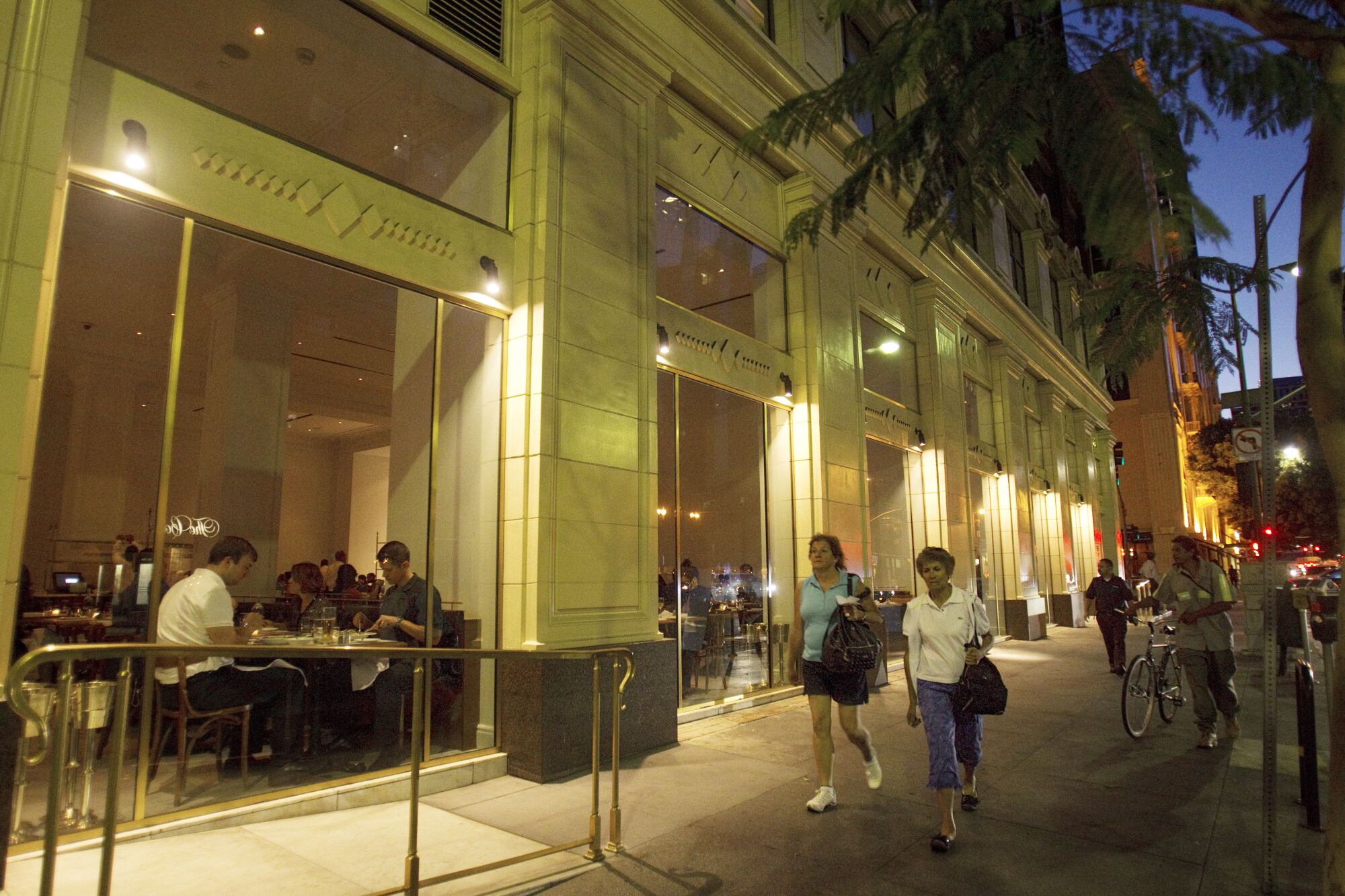
Pedestrians walk past Bottega Louie in downtown Los Angeles.
(Los Angeles Times)
The couple likes being near Bottega Louie, a popular Whole Foods grocery store and the recently opened Hotel Per La, which took over a lavishly refurbished 1920s building last occupied by another hotel that closed early in the pandemic.
“I can see business picking up,” Riley said. “This is an opportunity from a terrible tragedy like COVID. We wouldn’t have had this otherwise.”
A key factor keeping downtown teetering between recovery and a further downward slide appears to be discomfort with the streets and the sense that they are not as safe as they were before the pandemic.
The blocks close to Metro’s underground 7th Street/Metro Center station where, multiple light and heavy rail train lines meet, are among those that have changed most since the pandemic as the Metro system struggles to combat rampant drug use and serious crimes such as robbery, rape and aggravated assault on its lines.

A man rests near office buildings and an outdoor mall in downtown’s financial district.
(Dania Maxwell/Los Angeles Times)
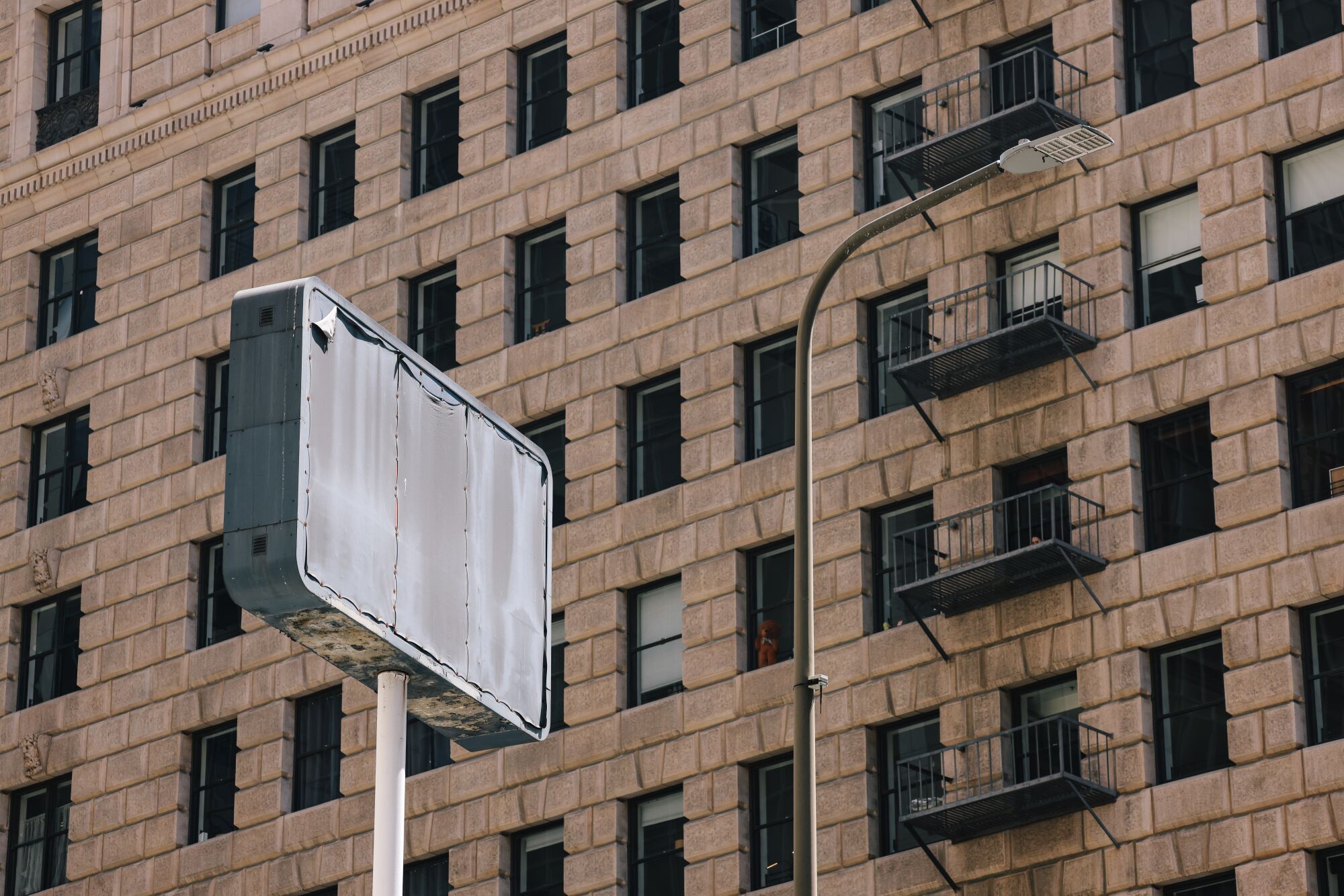
An empty sign in the financial district downtown, which is struggling to recover from the pandemic.
(Dania Maxwell/Los Angeles Times)
The growing number of homeless people on the streets has been an issue in other cities too, said Cognian of Public School. His company also closed restaurants in Seattle and San Francisco because customers at their urban locations trickled away as unhoused people commandeered the sidewalks.
“Hopefully, we as a city, as a state, find a solution for the homeless,” he said. “If the homeless situation doesn’t get solved in some fashion that allows tourists, office workers and businesses to operate, it’s just going to bring down the area.”
Real estate broker Derrick Moore of CBRE, who specializes in matching restaurant and shop operators with landlords, said retail space leasing downtown has improved in recent months, especially compared to the dark days of the 2020 pandemic shutdown when downtown fell silent.
“It seems like ancient history,” Moore said, “but it was very devastating to one’s psyche.” And to downtown businesses.
In the wake of the COVID shutdown, downtown overall lost more than 100 food and beverage establishments with a combined footprint of more than 1 million square feet, Moore said.
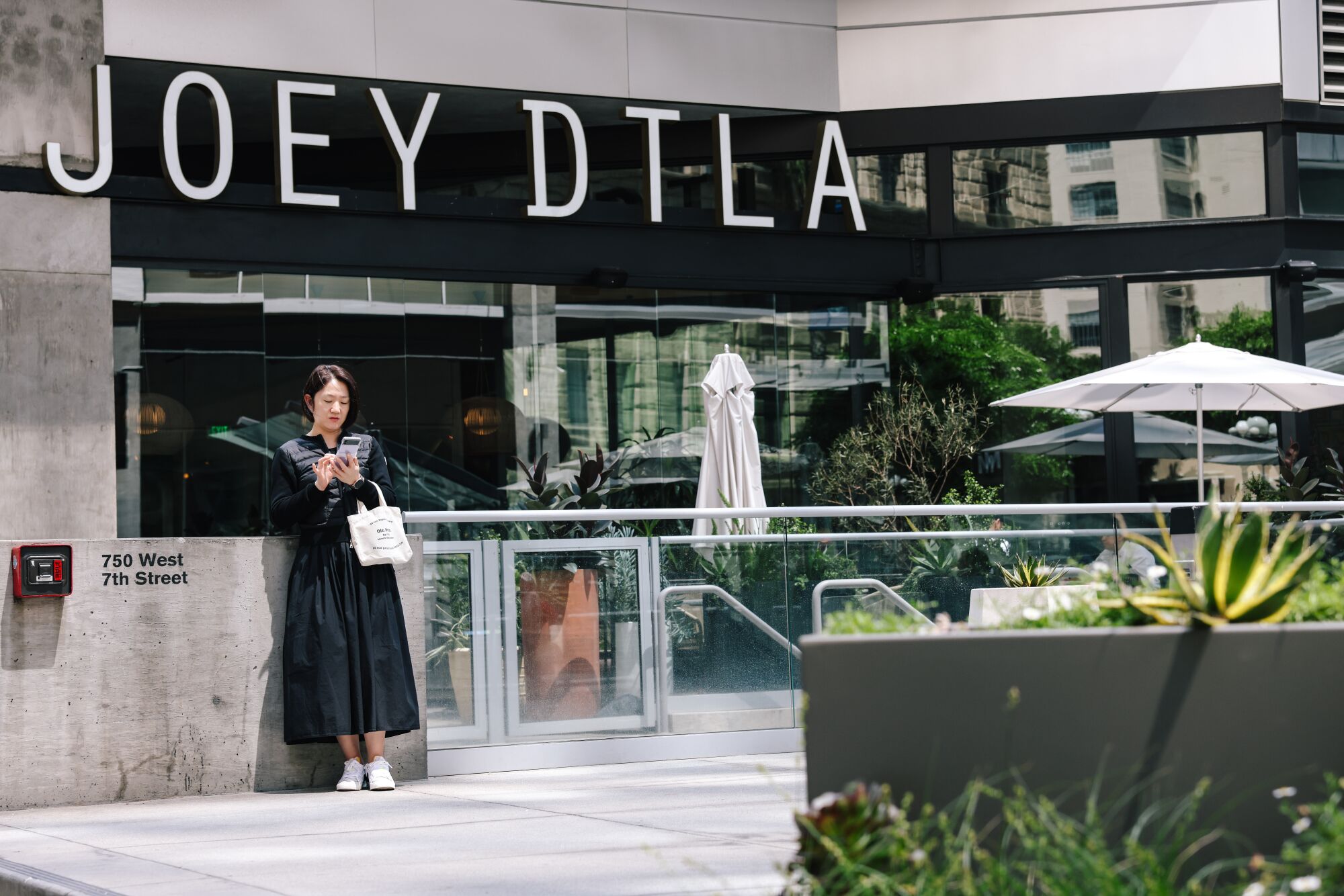
A woman stands outside Joey DTLA restaurant in downtown’s financial district.
(Dania Maxwell/Los Angeles Times)
“That’s restaurants, bars and lounges, juice bars, boutique coffee operators and even national brands,” Moore said. “A good portion of those remain vacant.”
Replacement tenants like Joyce restaurant are starting to come in, he said, with leasing and property showings picking up in the first quarter at a “resoundingly” busier pace than early 2022. Moore has taken potential tenants to the empty Public School space, where across the street the failed Standard hotel just reopened under new management as the Delphi.
Faced with a challenging market, retail landlords have cut their asking rents as much as 50% from pre-COVID prices, Moore said, and more than doubled the amount they are willing to spend on tenant upgrades such as installing restaurant kitchens and restrooms, and providing periods of free rent.
The financial district also faces a struggle of changing tastes, with many firms bypassing the gleaming skyscrapers that were the height of prestige in the late 20th century in favor of campus-style offices and a more laid-back vibe.
Even legal firms, long a stalwart in the financial district, are turning elsewhere in some cases. One firm formed in February recently opted out of putting its office there.
“When we started to look at space it became very clear to us that locating in the financial district was a very different proposition than it used to be,” said Matt Umhofer, a partner at Umhofer, Mitchell & King. “Downtown has changed dramatically, and we wanted to rethink what it means to be a law firm in Los Angeles and let go of preconceived notions of needing to be in the financial district in order to be relevant.”
The fledgling firm opted instead for an office in Row DTLA, a campus of shops, restaurants and offices created out of century-old warehouses near the Arts District, east of the financial center, even though office rents in the Arts District are often higher than they are in the glitzy skyscrapers.
“The short version is, being in the financial district isn’t as cool as maybe it was in the past,” Umhofer said.
The spotty attendance of office workers has changed the character of business centers across the country, said Mark Grinis, leader of consulting firm EY‘s real estate, hospitality and construction practice.
Analysis by EY found that offices are being used at only 25% to 50% of the level they were before the pandemic.
“In some locations, three-quarters of the people that normally would have gone in, didn’t,” Grinis said. “People are not on the subway, ordering sandwiches at lunch or having a drink after work.”
Vacant offices and storefronts can hinder recovery he said, because people shy away from empty spaces.
“Three blocks of vacant houses in a residential neighborhood ultimately becomes a negative,” he said. “An office center is not that different.”
The physical appearance of vacancy gets more alarming when graffiti, litter and grime follow and create a bad “multiplier effect,” Grinis said.
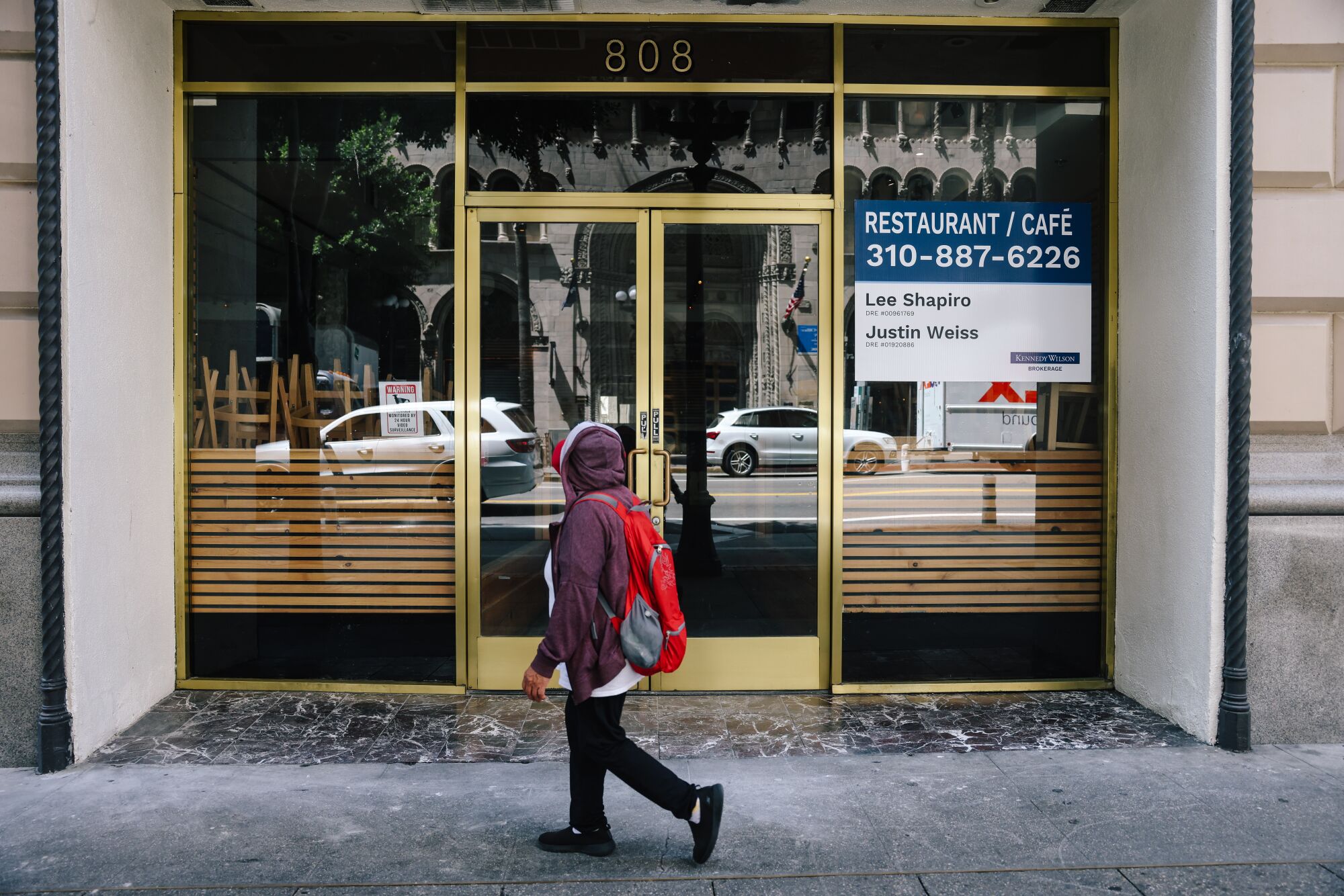
A vacant restaurant site for rent in the financial district.
(Dania Maxwell/Los Angeles Times)
Stopping the spiral starts with making the streets safe and getting homeless residents into better housing, but there are also public policy decisions that could help landlords convert office buildings to housing if they are no longer competitive on the office leasing market.
And the market has been brutal. Owners of some of downtown’s office high-rises have faced defaults, foreclosures and rushed sales in the face of falling demand, real estate data provider CoStar said.
The owner of two of the financial district’s premier office towers, 777 Tower and Gas Company Tower, said in February that it defaulted on loans tied to the buildings. Other high-rise owners are in similar straits.
In the face of rising vacancy rates, “those defaults could signal pain to come for the 69-million-square-foot downtown L.A. office market,” CoStar said.
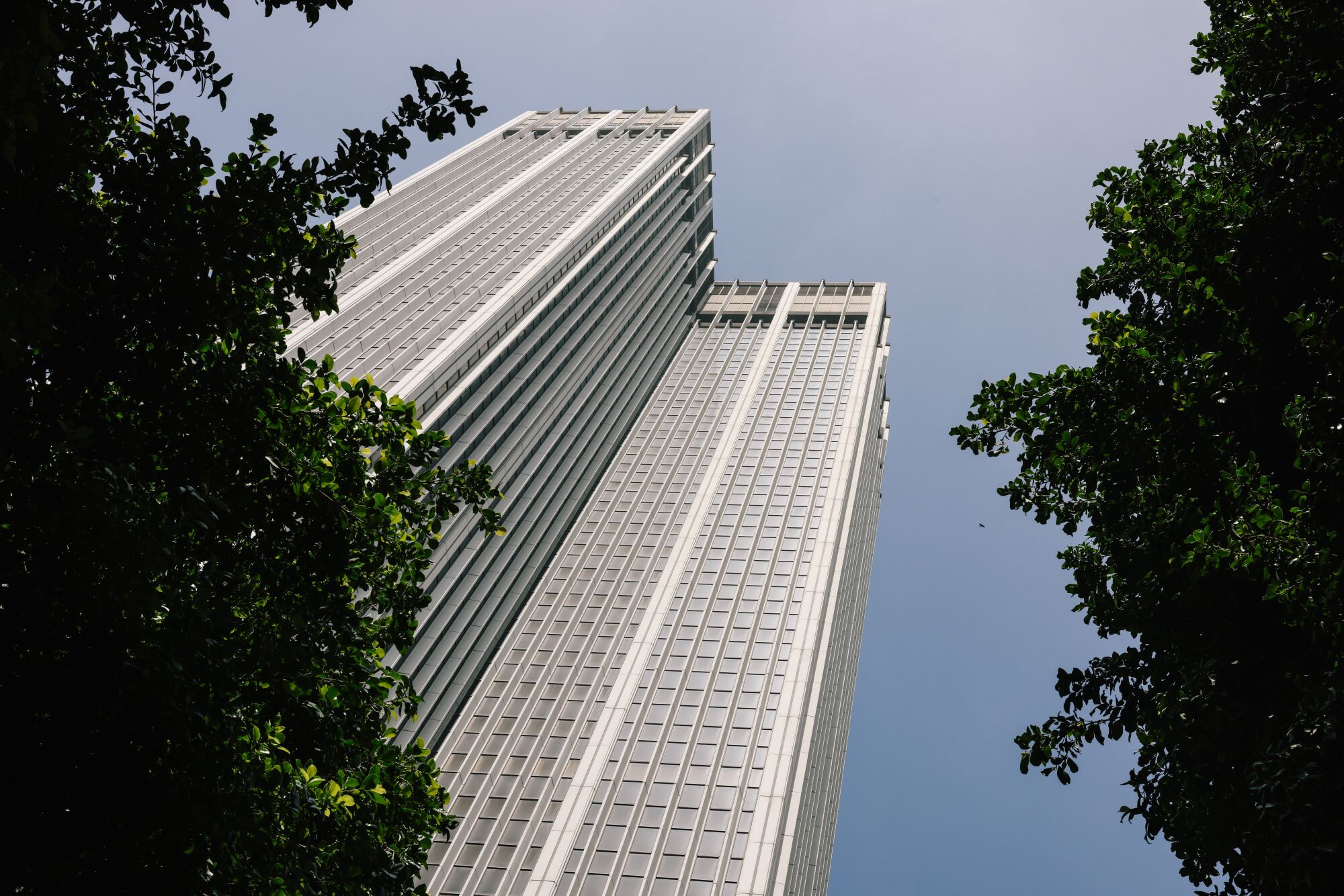
A long-vacant 1960s office tower in the financial district that was designed by noted midcentury architect William Pereira.
(Dania Maxwell/Los Angeles Times)
Owners of buildings facing foreclosure sometimes don’t have enough money to build out new tenants’ offices, as is customary, which hinders strapped landlords from recovering financially.
Commercial landlords are getting hit on multiple fronts, said Jessica Lall, managing director of the downtown office of CBRE.
“What we’re seeing is a perfect storm when it comes to the office distress in downtown L.A.,” she said.
Loans on large-scale properties are maturing at a time when interest rates are high, making refinancing a challenge, Lall said. There is widespread uncertainty among tenants about how much space they will need to rent in the future if employees work remotely at least some of the time.
Those issues are compounded by “the general perception around downtown being unsafe,” she said. “All urban centers are grappling with that issue right now.”
The downtown office vacancy rate — the share of total space that is unleased — climbed to 24% in the first quarter, up from 21.1% a year ago, according to CBRE. More empty space is coming, the brokerage said, pushing estimated availability to a daunting 30% as some companies shrink their offices or move away from downtown.
Law firm Skadden, for example, a large longtime tenant in downtown’s Bunker Hill district, has decided to move its offices to Century City .
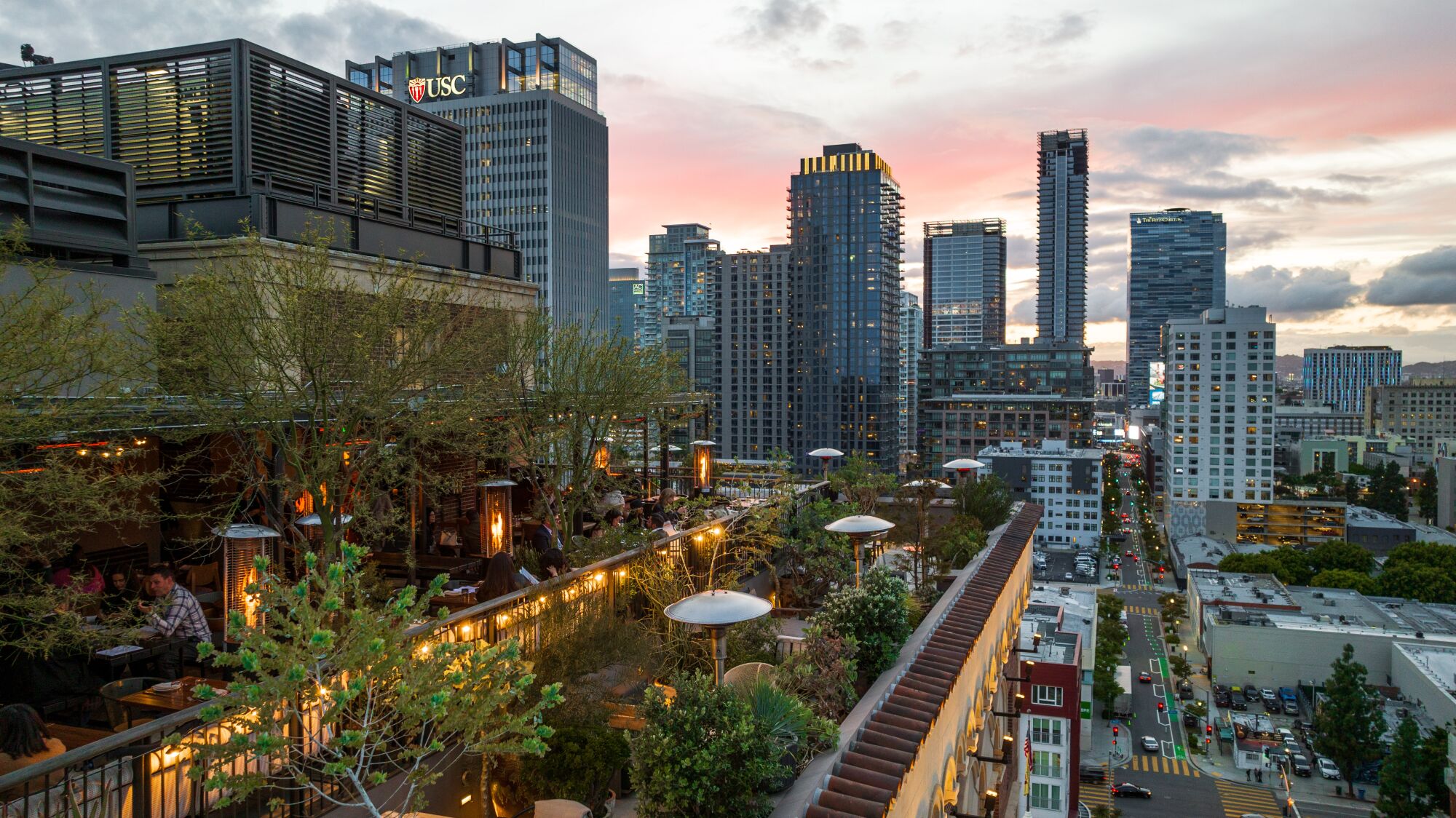
A view of the downtown Los Angeles skyline from the Cara Cara Rooftop Bar.
(Brian van der Brug/Los Angeles Times)
The landlord of the U.S. Bank Tower, downtown’s tallest office tower at 72 stories, remains bullish on the market in spite of its troubles and recently spent $60 million to make the building more attractive to tenants by adding hotel-like amenities.
“People need offices,” said Marty Burger, chief executive of Silverstein Properties, which owns the tower. “Not every company in every industry needs an office, but the majority of them do.”
Among the reasons for offices are collaboration and education, he said. “How do you mentor the young folks who are coming up in your industry if the older people aren’t in the office for younger people to learn from? There is a whole ecosystem where you need people in an office now.”
Companies may end up using their offices fewer days of the week than they used to as remote work and shortened schedules grow in popularity, he acknowledged: “Fridays may never be Fridays again.”
Burger says his optimism about downtown L.A.’s potential for improvement has a foundation in New York, where Silverstein built One World Trade Center on the site of the Twin Towers.
“After 9/11, everyone said that no one would ever live there or work there again,” Burger said.
In 2001, the neighborhood had about 20,000 residents and saw little activity after office hours. Now rebuilt, the neighborhood has about 75,000 residents and a greater mix of office tenants including businesses in tech and advertising in what was mostly a banking center before, Burger said.
“It’s a vibrant 24/7 community,” he said.
Many see this as the best future for L.A.’s financial district
The city’s tight housing market combined with the downturn in office rentals opens the possibility to convert some office buildings into housing or hotels.
More residents and visitors would make the neighborhood more dynamic and better able to support restaurants, shops and nightlife, said Griffin, executive director of the privately funded Downtown Center Business Improvement District, a nonprofit coalition of more than 2,000 property owners.
“If we trade some office for residential, that’s a good thing.”
The pandemic’s blow to the office market “is an opportunity that none of us ever imagined happening,” Welborne said, “transforming office buildings into residential buildings and reimagining our entire downtown.”

Business
Trump Is Said to Consider Executive Order to Circumvent TikTok Ban

President-elect Donald J. Trump is considering an executive order to allow TikTok to continue operating despite a pending legal ban until new owners are found, according to a person with knowledge of the matter.
The possible executive order, reported earlier by The Washington Post, is under discussion as TikTok faces a deadline on Sunday to be banned in the United States unless it finds a new owner. The popular video-sharing app is owned by ByteDance, a Chinese company. Republicans have said for years that they see the app, which has been downloaded to millions of smartphones, as a national security risk. It has become a rare issue that has united both parties in Congress.
If the Supreme Court upholds the law, which will ban the app unless ByteDance sells it to a non-Chinese company, special treatment from Mr. Trump might be the only way for TikTok to continue operating in the United States in the near term. The law requires app store operators like Apple and Google and cloud computing providers to stop distributing TikTok in the United States.
An executive order could try to direct the government not to enforce the law or to delay enforcement to complete a deal, a move that past presidents have used to challenge laws. It is unclear if an executive order would survive legal challenges or persuade the app stores and cloud computing companies to take steps that could expose them to huge penalties.
Alan Z. Rozenshtein, a former national security adviser to the Justice Department and a professor at the University of Minnesota Law School, said an executive order should be “taken with a medium-sized boulder of salt.” Such an order is not a law, he said, and legally would not change the legislation passed by Congress and signed by President Biden.
While there is some speculation that the app will still work if it has already been downloaded, the law also affects internet hosting companies like Oracle and other cloud computing providers, and it is unclear how video load times and the functionality of the app may respond.
One person close to Mr. Trump’s team said some of his allies had loose discussions about buying TikTok but provided no details. Mr. Biden, whose term ends on Monday, a day after the ban is set to go into effect, is also under pressure to find a way to save the app.
The New York Times reported late Wednesday that TikTok’s chief executive, Shou Chew, is expected to attend Mr. Trump’s inauguration on Monday and was offered a seat on the dais. TikTok declined to comment.
Mr. Chew is expected to be joined by other tech executives on the dais: Mark Zuckerberg, the co-founder of Meta; Jeff Bezos, the Amazon founder; Elon Musk, Mr. Trump’s megadonor; and Tim Cook, the chief executive of Apple, who personally donated $1 million to the inaugural committee.
Mr. Trump had previously backed a TikTok ban but publicly changed his stance last year, soon after meeting with Jeff Yass, a Republican megadonor who owns a large share of ByteDance.
Mr. Trump has said they did not discuss the company. But Mr. Yass helped found the trading firm Susquehanna International Group and is one of the biggest supporters of the conservative lobbying group Club for Growth. The group has hired people with ties to Mr. Trump, such as Kellyanne Conway, his former top adviser, and the Republican adviser David Urban, to lobby for TikTok in Washington.
TikTok has also worked to make inroads with the Trump team through Tony Sayegh, who was a Treasury official during Mr. Trump’s first administration and now leads public affairs for Susquehanna.
Mr. Sayegh has relationships with the Trump family and was a core part of the campaign’s decision to join TikTok this summer. Several members of the family, including Ivanka Trump, Donald Trump Jr. and Kai Trump, the president-elect’s granddaughter, have also joined the app.
Mr. Trump’s interest in TikTok is not entirely because of his advisers. He came to see how well videos about him performed on the platform, and his advisers credited it with helping him to expand his reach to a new type of voter during the campaign.
Any actions Mr. Trump might be able to take on TikTok are complicated. The law gives the president the ability to extend the deadline for a sale only if there is “significant progress” toward a deal that would put the company in the hands of a non-Chinese owner.
It also requires that the deal be possible to complete within 90 days of an extension. It is unclear exactly how an extension will work if Mr. Trump tries to deploy it after the ban takes effect.
TikTok has maintained throughout its court challenge to the law that such a sale is unworkable in part because of the prescribed time frame. A group led by the billionaire Frank McCourt has mounted a bid to buy the app — though without its mighty algorithm — in recent months.
Mr. Trump could also try to work around the law by instructing the government not to enforce it.
But app store operators and cloud computing providers could require more than a soft assurance from Mr. Trump that he will not punish them if they fail to execute the ban, said Ryan Calo, a professor at the University of Washington School of Law. The potential legal liability for companies that violate the law is significant: Penalties are as high as $5,000 per person who is able to use TikTok once the ban is in effect.
“You could have a policy not to enforce this ban,” said Mr. Calo, who was part of a group of professors who urged the Supreme Court to overturn the TikTok law. “But I think that maybe conservative companies would just be like: ‘OK, you’re not going to enforce it. But it is on the books, and you could enforce at any time.’”
Mr. Trump’s pick for attorney general, Pam Bondi, has declined to say whether she would enforce the law.
“I can’t discuss pending litigation,” she said at her Senate confirmation hearing on Wednesday. “But I will talk to all the career prosecutors who are handling the case.”
Mr. Trump has a third option: appealing to Congress to reverse a policy it overwhelmingly approved with broad bipartisan support last year.
“Congress can undo this anytime,” Mr. Calo said.
On Thursday, Senator Chuck Schumer of New York, the Democratic leader, said on the Senate floor that he was worried about the possibility of a ban on TikTok.
“It’s clear that more time is needed to find an American buyer and not disrupt the lives and livelihoods of millions of Americans, of so many influencers who have built up a good network of followers,” he said. He added that he had also made those views clear to the Biden administration and accused Republicans of blocking a bill that would have extended the deadline for a ban by 270 days.
A White House official said on Thursday that the administration’s clear view was that TikTok should operate with an American owner. Because of the timing of the potential ban — taking place over a holiday weekend before the inauguration — it would fall to the next administration to carry out the law, the official said.
Catie Edmondson contributed reporting.
Business
Waters and Sherman introduce bill to address gaps in wildfire insurance coverage

Two California representatives in Washington are trying to combat the state’s home insurance crisis that has left many residents without coverage as wildfires tear through the Los Angeles area.
Reps. Maxine Waters (D-Los Angeles) and Brad Sherman (D-Sherman Oaks) reintroduced on Thursday the Wildfire Insurance Coverage Study Act, which calls for an assessment of the home insurance market in communities with high wildfire risk. The bill easily passed the House Financial Services Committee with bipartisan support last Congress, but was pulled from consideration before getting a vote by the full House.
The bill’s return comes after a week of desperate firefighting in Southern California, where entire neighborhoods have been reduced to ash and rubble. The fires have claimed thousands of homes and businesses in the Pacific Palisades, Malibu, Altadena and other communities.
Before the fires sparked, the home insurance market in California was already in crisis as insurers opted not to renew thousands of policies in areas deemed to be at high risk of fires, including those that were hit by the current blazes. Some homeowners who didn’t have their coverage canceled saw their rates rise sharply.
“Over the years we’ve watched insurance companies raise premiums, reduce coverage, and abandon wildfire coverage in high-risk areas altogether,” Waters said in a statement. “This leaves families and businesses throughout the state of California without the resources they need to recover.”
The Wildfire Insurance Coverage Study Act would require the Government Accountability Office to examine the availability and affordability of home insurance in fire-prone areas. The GAO would also gather data on disparities in access to wildfire coverage and make recommendations for federal actions to stabilize insurance markets.
“The devastating fires in my district and the greater Los Angeles area underscore the need for Congress to focus on the availability and cost of fire insurance coverage,” Sherman said.
Although insurance is a state-regulated industry, Waters said her bill would “help Congress and the federal government better understand what federal tools are available to respond to the risks posed by wildfires.”
The bill also calls for an inquiry into the role climate change plays in exacerbating wildfires.
Also this week, California lawmakers introduced legislation they hope will fill gaps in support for renters and homeowners affected by the fires, as well as the inmate firefighters the state relies on.
On Wednesday, Rep. Isaac Bryan (D-Los Angeles) proposed a bill to raise the pay for inmate firefighters during the hours that they are “actively fighting a fire” to match the rate of the lowest professional state firefighter wage.
California has long relied on incarcerated firefighters on the front lines, with hundreds of prison firefighters deployed in Los Angeles in recent days. The practice has drawn criticism from some for the meager pay these inmates receive for the potentially life-threatening work.
The firefighters make between $5.80 and $10.24 daily as well as an additional $1 hourly wage on the front lines, for shifts that can last as long as 24 hours, according to the California Department of Corrections and Rehabilitation.
“We are seeing our incarcerated folks putting their lives in harm’s way and protecting whole communities,” Bryan said in an interview. “We bring up how they are doing this work for slave wages, but we never do anything about it.”
Rep. John Harabedian (D-Riverside) introduced this week AB 238, a bill aimed at delivering financial relief to Californians forced to shoulder payments for both temporary housing and mortgages simultaneously.
Another bill, AB 246, calls for a rent freeze across Los Angeles County and would create a civil penalty for landlords who violate it. The effort comes as L.A. City Council moved to bar evictions for some tenants and pets amid the emergency.
Business
On TikTok, Users Thumb Their Noses at Looming Ban

Over the last week, the videos started appearing on TikTok from users across the United States.
They all made fun of the same thing: how the app’s ties to China made it a national security threat. Many implied that their TikTok accounts had each been assigned an agent of the Chinese government to spy on them through the app — and that the users would miss their personal spies.
“May we meet again in another life,” one user wrote in a video goodbye set to Whitney Houston’s cover of Dolly Parton’s “I Will Always Love You.” The video included an A.I.-generated image of a Chinese military officer.
The videos were just one way that some of TikTok’s 170 million monthly U.S. users were reacting as they prepared for the app to disappear from the country as soon as Sunday.
The Supreme Court is set to rule on a federal law that required TikTok’s Chinese owner, ByteDance, to sell the app by Jan. 19 or face a ban in the United States. U.S. officials have said China could use TikTok to harvest Americans’ private data and spread covert disinformation. TikTok, which has said a sale is impossible and challenged the law, is now awaiting the Supreme Court’s response.
The possibility that the justices will uphold the law has set off a palpable sense of grief and dark humor across the app. Some users have posted videos suggesting ways to circumvent a ban with technological workarounds. Others have downloaded another Chinese app, Xiaohongshu, also known as “Red Note,” to thumb their noses at the U.S. government’s concerns about TikTok’s ties to China.
The videos highlight the collision taking place online between the law, which Congress passed with wide support last year, and everyday users of TikTok, who are dismayed that the app may soon disappear.
“Much of my TikTok feed now is TikTokers ridiculing the U.S. government, TikTokers thanking their Chinese spy as a form of ridicule,” said Anupam Chander, a professor of law and technology at Georgetown University and an expert on the global regulation of new technologies. “TikTokers recognize that they are not likely to be manipulated by anyone. They are actually quite sophisticated about the information they’re receiving.”
TikTok declined to comment on the users’ references to its ties to China.
Some users are not willing to give up the app — or their supposed spies — so easily.
Hundreds of TikTok videos over the last week have cataloged how teenagers could keep using the app in the United States, according to a review by The New York Times. One of the most popular methods described is the use of a VPN, or a virtual private network, which can mask a user’s location and make it appear that the person is elsewhere.
“They can’t actually ban TikTok in the U.S. because VPNs are not banned,” Sasha Casey, a TikTok user, said in a recent video that was liked over 60,000 times. “Use a VPN. And send a picture to Congress while you do it, because that’s what I’ll be doing.”
While VPNs can make it appear that a phone, a laptop or another electronic device is in a remote location, it is not clear if the technology can circumvent the ban. A device’s real location is stored in many places, including in the app store that was used to download TikTok.
TikTok fans also seem to be behind the sudden surge in popularity for Xiaohongshu, the most downloaded free app on Tuesday and Wednesday in the U.S. Apple Store. Hundreds of millions of people in China use the app, which, like TikTok, features short videos and text-based posts. Xiaohongshu means “little red book” in Mandarin.
Mr. Chander anticipates that the Supreme Court will uphold the ban law this week, though he believes that TikTok has the winning case. He said the downloads of Red Note and the Chinese spy memes showed that many Americans did not agree with their government’s security concerns, particularly at the expense of free speech.
“When the United States shutters a massive free expression service, which our democratic allies have not shuttered, it will make us the censor and put us in the unusual position of silencing expression,” Mr. Chander said. “It will make Americans who use TikTok really distrustful of the U.S. government as carrying their best interests.”
-
/cdn.vox-cdn.com/uploads/chorus_asset/file/25822586/STK169_ZUCKERBERG_MAGA_STKS491_CVIRGINIA_A.jpg)
/cdn.vox-cdn.com/uploads/chorus_asset/file/25822586/STK169_ZUCKERBERG_MAGA_STKS491_CVIRGINIA_A.jpg) Technology1 week ago
Technology1 week agoMeta is highlighting a splintering global approach to online speech
-

 Science5 days ago
Science5 days agoMetro will offer free rides in L.A. through Sunday due to fires
-
/cdn.vox-cdn.com/uploads/chorus_asset/file/25821992/videoframe_720397.png)
/cdn.vox-cdn.com/uploads/chorus_asset/file/25821992/videoframe_720397.png) Technology1 week ago
Technology1 week agoLas Vegas police release ChatGPT logs from the suspect in the Cybertruck explosion
-

 Movie Reviews1 week ago
Movie Reviews1 week ago‘How to Make Millions Before Grandma Dies’ Review: Thai Oscar Entry Is a Disarmingly Sentimental Tear-Jerker
-

 News1 week ago
News1 week agoPhotos: Pacific Palisades Wildfire Engulfs Homes in an L.A. Neighborhood
-

 Business1 week ago
Business1 week agoMeta Drops Rules Protecting LGBTQ Community as Part of Content Moderation Overhaul
-

 Politics1 week ago
Politics1 week agoTrump trolls Canada again, shares map with country as part of US: 'Oh Canada!'
-

 Education1 week ago
Education1 week agoFour Fraternity Members Charged After a Pledge Is Set on Fire











